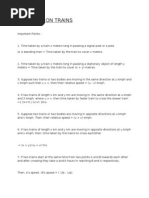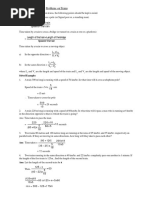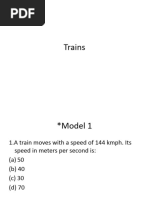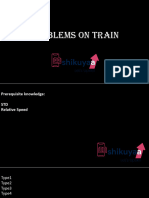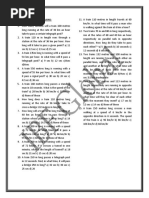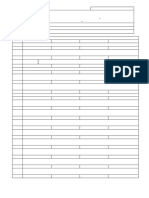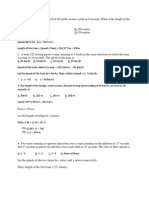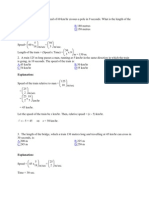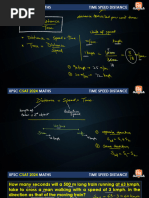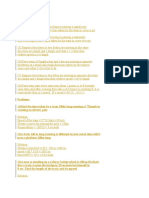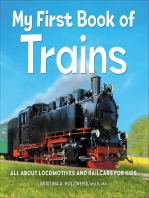Quantitative Aptitude: Trains
Quantitative Aptitude: Trains
Uploaded by
dassreerenjiniCopyright:
Available Formats
Quantitative Aptitude: Trains
Quantitative Aptitude: Trains
Uploaded by
dassreerenjiniOriginal Description:
Original Title
Copyright
Available Formats
Share this document
Did you find this document useful?
Is this content inappropriate?
Copyright:
Available Formats
Quantitative Aptitude: Trains
Quantitative Aptitude: Trains
Uploaded by
dassreerenjiniCopyright:
Available Formats
Quantitative Aptitude
TRAINS
This chapter is basically an extension of the T i m e
and Distance". Therefore, we will use here the basic
concepts like Speed, Relative Speed already discussed
in the earlier chapter. Here, the focus will be exclusively on problems related to trains. The variables involved are again the sameTime, Distance and Speed.
Assumptions : For all purposes, unless otherwise
specifically mentioned, we will assume that the speed
at which the train(s) covers the distance or performs
the journey remains constant over the journey which
we call the average speed. The size of the person, telegraph post, pole etc. is negligible in comparison to the
length of the train or the platform.
Important General Cases :
(0 Time ft) taken by a train x metres long to cross
a stationary person or pole or signal post is equal to
the time taken by the train to cover the distance x
metres (equal to its own length) with its own speed (u).
QUESTIONS FOR PRACTICE
1. A train, 300m long, passed a man, walking along
the line in the same direction at the rate of 3
km/hr in 33 seconds. The speed of the train is
(l)30km/h
(2)32km/h
2. Two trains started at the same time, one from A
to B and the other from B to A. If they arrived at
B and A respectively 4 hours and 9 hours after
they passed each other, the ratio of the speeds of
the two trains was
(1)2:1
(2)3:2
(3) 4 : 3
(4) 5 : 4
3. Two trains of equal length, running in opposite
directions, pass a pole in 18 and 12 seconds. The
trains will cross each other in
(1) 14.4 seconds
(2) 15.5 seconds
(3) 18.8 seconds
(4) 20.2 seconds
4. A moving train crosses a man standing on a platform and a bridge 300 metres long in 10 seconds
and 25 seconds respectively. What will be the time
taken by the train to cross a platform 200 metres
long?
2
(1) 16 seconds
(2) 18 seconds
(3) 20 seconds
(4) 22 seconds
5. A train covers a distance of 3584 km in 2 days 8
hours. If it covers 1440 km on the first day and
1608 km on the second day, by how much does
the average speed of the train for the remaining
part of the journey differ from that for the entire
journey ?
(1) 3 km/hour more
(2) 3 km/hour less
(3) 4 km/hour more
(4) 5 km/hour less
6. A train, 150m long, passes a pole in 15 seconds
and another train of the same length travelling
in the opposite direction in 12 seconds. The speed
of the second train is
(l)45km./hr
(2)48km./hr
(3) 52 km./hr
(4) 54 km./hr
7. A train travelling at 48 km/hr crosses another
train, having half its length and travelling in opposite direction at 42 km/hr, in 12 seconds. It
also passes a railway platform in 45 seconds. The
length of the railway platform is
(l)200m
(2) 300m
(3) 350 m
(4) 400 m
8. Two trains 105 metres and 90 metres long, run at
the speeds of 45 km/hr and 72 km/hr respectively, in opposite directions on parallel tracks.
The time which they take to cross each other, is
(1)8 seconds
(2) 6 seconds
(3) 7 seconds
(4) 5 seconds
9. A train travelling at a speed of 30 m/sec crosses
a platform, 600 metres long, in 30 seconds. The
length (in metres) of train is
(1) 120
(2) 150
(3) 200
(4) 300
10. A train passes a platform 110 m long in 40 seconds and a boy standing on the platform in 30
seconds . The length of the train is
(l)lOOm
(2) 110 m
(3) 220 m
(4) 330 m
11. A train with a uniform speed passes a platform,
122 metres long, in 17 seconds and a bridge, 210
metres long, in 25 seconds. The speed of the train
is
(1) 46.5 km/hour
(2) 37.5 km/hour
(3) 37.6 km/hour
(4) 39.6 km/hour
12. A train passes a platform 90 metre long in 30
seconds and a man standing on the platform in
15 seconds. The speed of the train is :
(l)12.4kmph
(2) 14.6kmph
(3) 18.4 kmph
(4) 21.6 kmph
13. A train passes two persons walking in the same
direction at a speed of 3 km/hour and 5km/hour
respectively in 10 seconds and 11 seconds respectively. The speed of the train is
(1)28 km/hour
(2) 27 km/hour
(3) 25 km/hour
(4) 24 km/hour
14. A 360 metre long train crosses a signal post in 18
seconds. What is the speed of the train in km per
hour?
(1) 76
(2) 60
(3) 64
(4) 72
15. A train passes two bridges of lengths 800 m and
400 m in 100 seconds and 60 seconds respectively.
The length of the train is :
(l)80m
(2) 90 m
(3) 200 m
(4) 150 m
16. A train 300 metres long is running at a speed of
25 metres per second. It will cross a bridge of 200
metres in
(1) 5 seconds
(2) 10 seconds
(3) 20 seconds
(4) 25 seconds
17. A train is 125 m long. If the train takes 30 seconds to cross a tree by the railway line, then the
speed of the train is
(1)14 km/hr
(2) 15 km/hr
(3) 16 km/hr
(4) 12 km/hr
18. A train passes two bridges of lengths 800 m and
400 m in 100 seconds and 60 seconds respectively.
The length of the train is
(l)80m
(2) 90 m
(3) 200 m
(4) 150 m
19. A train takes 3 hours to run from one station to
another. If it reduces its speed by 12 km/hr, it
takes 45 minutes more for the journey. The distance between the stations is
(1)220 km
(2) 210 km
(3) 180 km
(4) 160 km
20. The length of a train and that of a platform are
equal. If with a speed of 90 km/hr the train crosses
the platform in one minute, then the length of
the train (in metres) is
(1) 500
(2) 600
(3) 750
(4) 900
21. A train travelling with a speed of 60 km/hr catches
another train travelling in the same direction and
then leaves it 120 m behind in 18 seconds. The
speed of the second train is
(1) 26 km/hr
(2) 35 km/hr
(3) 36 km/hr
(4) 63 km/hr
22. Two stations X and Y are 900km apart. A train
starts from X and moves towards Y at 70 km/hr.
Another train starts from Y at the same time
and moves towards X at 80 km/hr. How far from
X will they cross each other ?
(1)150 km
(2) 300 km
(3) 420 km
(4) 450 km
23. A train with a uniform speed crosses a pole in 2
seconds and a bridge of length 250m in 7 seconds. The length of the train is
(1) 150 m
(2) 120 m
(3) 100 m
(4) 80 m
24. A train, 300m long, passed a man, walking along
the line in the same direction at the rate of 3
km/hr in 33 seconds. The speed of the train is
(1)30 km/h
(2) 32 km/h
25. A train. 240 m long crosses a man walking along
the line in opposite direction at the rate of 3 kmph
in 10 seconds. The speed-of the train is
(1)63 kmph
(2) 75 kmph
(3) 83.4 kmph
(4) 86.4 kmph
ANSWERS
1.(4)
6. (4)
11.(4)
16. (3)
21. (3)
2.
7.
12.
17.
22.
(2)
(4)
(4)
(2)
(3)
3.(1)
8. (2)
13. (3)
18. (3)
23. (3)
4.
9.
14.
19.
24.
(3)
(4)
(4)
(3)
(4)
5.(1)
10. (4)
15. (3)
20. (3)
25. (3)
You might also like
- The Information Design HandbookDocument129 pagesThe Information Design HandbookDomênica P.50% (2)
- Name of The Group Members ID NumberDocument5 pagesName of The Group Members ID Numbersarayont87% (15)
- A. Hillerborg-Strip Method Design Handbook-CRC Press (1996)Document333 pagesA. Hillerborg-Strip Method Design Handbook-CRC Press (1996)Nabigh Ahmad100% (5)
- Wisc and Its SubtestsDocument3 pagesWisc and Its SubtestsSaroja Roy67% (3)
- Time and DistanceDocument7 pagesTime and Distanceprakhar0546882No ratings yet
- Time Speed and DistanceDocument5 pagesTime Speed and Distancepankajchaurasiachaurasia96No ratings yet
- Nice Aptitude Problems With AnswersDocument45 pagesNice Aptitude Problems With Answersratnesht87100% (2)
- Problems On Trains: Length of T He Train SpeedofthetrainDocument3 pagesProblems On Trains: Length of T He Train SpeedofthetrainrohitNo ratings yet
- Problems On TrainsDocument38 pagesProblems On TrainsSanjay PahadeNo ratings yet
- Problems On Trains Practice NotesDocument31 pagesProblems On Trains Practice Notesbiscuit ovhalNo ratings yet
- Chapter 19.1Document28 pagesChapter 19.1narasimha100% (1)
- Arithmetic TrainsDocument2 pagesArithmetic TrainsPooja SweetieNo ratings yet
- Problems On TrainsDocument5 pagesProblems On Trainsz1y2No ratings yet
- TRAINSDocument17 pagesTRAINSdchinmayadas111No ratings yet
- Trains (Updated) 1Document52 pagesTrains (Updated) 1MeghnadhNo ratings yet
- TIME AND DISTANCE - 1 (TRAINS) For SSCDocument2 pagesTIME AND DISTANCE - 1 (TRAINS) For SSCJanipalli HarishNo ratings yet
- TrainDocument24 pagesTrainvaibhav kuchekarNo ratings yet
- Problems On Trains, Boats and StreamsDocument42 pagesProblems On Trains, Boats and Streamsarmailgm100% (1)
- Aptitude QuestionsDocument518 pagesAptitude QuestionsDevanand KshirsagarNo ratings yet
- TrainquestionsDocument4 pagesTrainquestionskumarrajnish48030No ratings yet
- Prblem Based On Train For PDF WorkshhetDocument17 pagesPrblem Based On Train For PDF Workshhetsoumikdhara789No ratings yet
- SDT Practice QuestionsDocument11 pagesSDT Practice QuestionssaravanapriyasakthimuruganNo ratings yet
- Problems Based On TrainsDocument1 pageProblems Based On TrainsExam DostNo ratings yet
- Problems On Trains Boats and Streams1Document42 pagesProblems On Trains Boats and Streams1reenajose100% (1)
- UPC UNIT 6Document8 pagesUPC UNIT 6vjbookcenterNo ratings yet
- 1 17-Problems-on-Trains-unlockedDocument5 pages1 17-Problems-on-Trains-unlockedKuldeep KaurNo ratings yet
- Trains and Boats FinalDocument52 pagesTrains and Boats FinalSurya AnjuNo ratings yet
- 1-High Level Questions (TRAINS)Document5 pages1-High Level Questions (TRAINS)Olivier GOURDINNo ratings yet
- Probs On Trains Quiz 5 PDFDocument7 pagesProbs On Trains Quiz 5 PDFAbhishek KumarNo ratings yet
- Speed Time and Distance - Part 2Document76 pagesSpeed Time and Distance - Part 2mdtausifuzzamanNo ratings yet
- Time, Speed & Distance by Mayank SirDocument7 pagesTime, Speed & Distance by Mayank SirALL TIME MASTINo ratings yet
- UntitledDocument7 pagesUntitled19-028 KuldeepNo ratings yet
- TRAINSDocument5 pagesTRAINSTHE VISIONNo ratings yet
- TSD NewDocument1 pageTSD NewHamza ShaikhNo ratings yet
- TrainDocument7 pagesTrainSoumya DuttaNo ratings yet
- AptDocument3 pagesAptAnanda RamanNo ratings yet
- Time, Speed &distance 1Document5 pagesTime, Speed &distance 1Sankar KumarasamyNo ratings yet
- 4 Problem On TrainsDocument18 pages4 Problem On Trainsaavneet21No ratings yet
- DistanceDocument2 pagesDistanceGodwin AntoNo ratings yet
- Problem On TrainsDocument16 pagesProblem On TrainsSyed Tarooq AfnanNo ratings yet
- CUET QA-10.0_Time & Distance 2Document2 pagesCUET QA-10.0_Time & Distance 2Pavithra CBNo ratings yet
- TIME AND DISTANCE 117 QTNSDocument14 pagesTIME AND DISTANCE 117 QTNSmounireddy.0607No ratings yet
- Aptitude TrainDocument3 pagesAptitude TrainSathya NarayananNo ratings yet
- Time and DistanceDocument59 pagesTime and DistanceMunigela RavitejaNo ratings yet
- Trains 13 Into 13 by Pardeep SirDocument26 pagesTrains 13 Into 13 by Pardeep SirRam Shankar GargNo ratings yet
- Problems On Train - EasyDocument33 pagesProblems On Train - EasyRithik SenNo ratings yet
- TriansDocument4 pagesTriansapi-19525017No ratings yet
- SSSSDocument4 pagesSSSSGovindaraj GctNo ratings yet
- Speed & TimeDocument16 pagesSpeed & Timesivakumark2812No ratings yet
- Boats and TrainDocument6 pagesBoats and TrainYuvashree MahendranNo ratings yet
- TSD 2Document2 pagesTSD 2Deepankar Sadhan BanikNo ratings yet
- Time Speed DistanceDocument9 pagesTime Speed Distanceshamalac2004No ratings yet
- Problems On Trains For CLAT 2013: Important FormulasDocument5 pagesProblems On Trains For CLAT 2013: Important FormulasAnkit YadavNo ratings yet
- TRAINDocument2 pagesTRAINjalanvishal10No ratings yet
- 09 Time Speed Distance-1Document16 pages09 Time Speed Distance-1rohitpaswan48600No ratings yet
- Time and DistanceDocument20 pagesTime and DistancedassreerenjiniNo ratings yet
- TSD PDFDocument2 pagesTSD PDFbad guyNo ratings yet
- How To Prepare For AptitudeDocument61 pagesHow To Prepare For AptitudeAdarsh IyerNo ratings yet
- TodayDocument1 pageTodayWycliffe AnshulNo ratings yet
- Speed Distance and Time 1Document22 pagesSpeed Distance and Time 1yashwantlodhi121No ratings yet
- My First Book of Trains: All About Locomotives and Railcars for KidsFrom EverandMy First Book of Trains: All About Locomotives and Railcars for KidsNo ratings yet
- IBPS Clerk Question PaperDocument16 pagesIBPS Clerk Question PaperjagdishNo ratings yet
- Data Interpretaion (Missing DI)Document6 pagesData Interpretaion (Missing DI)dassreerenjiniNo ratings yet
- 2000 MCQ Ibps Clerk MainsDocument172 pages2000 MCQ Ibps Clerk Mainsdassreerenjini100% (1)
- Edristi Current Affairs Jan 2017 V2Document161 pagesEdristi Current Affairs Jan 2017 V2dassreerenjiniNo ratings yet
- 1000 Questions PDFDocument149 pages1000 Questions PDFManju Rana100% (1)
- HR-1 Y s2-NEWDocument17 pagesHR-1 Y s2-NEWdassreerenjiniNo ratings yet
- Budget-Terminologies and Concepts: Classification of Expenditure of GovernmentDocument3 pagesBudget-Terminologies and Concepts: Classification of Expenditure of GovernmentdassreerenjiniNo ratings yet
- Sugamya Bharat AbhiyanDocument10 pagesSugamya Bharat AbhiyandassreerenjiniNo ratings yet
- Indian Polity: For IES, SSC, IAS, PSU and Others Competitive ExaminationDocument59 pagesIndian Polity: For IES, SSC, IAS, PSU and Others Competitive ExaminationdassreerenjiniNo ratings yet
- Telecom Shelter FDNDocument3 pagesTelecom Shelter FDNSaqlain AwanNo ratings yet
- Table of Specification in Araling Panlipunan 2Document6 pagesTable of Specification in Araling Panlipunan 2Charisa BonghanoyNo ratings yet
- Numerology NumbersDocument11 pagesNumerology NumbersRam Prasad100% (1)
- Workshop Penulisan ThesisDocument24 pagesWorkshop Penulisan ThesisboynadauNo ratings yet
- 5990-7399EN - 200 Tablet HardnessDocument3 pages5990-7399EN - 200 Tablet HardnessElsayed ElazazyNo ratings yet
- University at Buffalo MATH 131 Midterm 1Document15 pagesUniversity at Buffalo MATH 131 Midterm 1Sally MistyNo ratings yet
- LEARNING OUTPUT EdD - Educational Planning and Management (ARMANDO B. CORTEZ)Document15 pagesLEARNING OUTPUT EdD - Educational Planning and Management (ARMANDO B. CORTEZ)Arman Berina CortezNo ratings yet
- Writing Manuals and Procedures: Group 6Document33 pagesWriting Manuals and Procedures: Group 6Five STARNo ratings yet
- Design StandardsDocument64 pagesDesign StandardsJayNo ratings yet
- MGS New Theme TransportationDocument1 pageMGS New Theme TransportationFarrukh AwanNo ratings yet
- Nusrat Fateh Ali Khan ComplDocument9 pagesNusrat Fateh Ali Khan ComplAvnish Chandra SumanNo ratings yet
- InterruptDocument28 pagesInterruptĐạtNguyễnNo ratings yet
- Citroen DS4 ANCAP PDFDocument2 pagesCitroen DS4 ANCAP PDFcarbasemyNo ratings yet
- Tuffstudds BrochureDocument8 pagesTuffstudds BrochureEhab Attia SelimNo ratings yet
- Python For Data ScienceDocument67 pagesPython For Data Sciencechaya presidencyNo ratings yet
- Assignment 4Document5 pagesAssignment 4tremendoustushar_10No ratings yet
- Coursework AnalysisDocument6 pagesCoursework Analysisuyyjcvvcf100% (2)
- Act Assignment PDFDocument14 pagesAct Assignment PDFchan hkNo ratings yet
- How To Create An Outline For A Term PaperDocument7 pagesHow To Create An Outline For A Term Paperc5rc7ppr100% (1)
- Article CritiqueDocument7 pagesArticle CritiqueSARA YASMIN RUSNIPANo ratings yet
- AEA0810151M035R - 47uf - KYOCERA AVX - SMD - 8.3 X 8.3 - AECDocument6 pagesAEA0810151M035R - 47uf - KYOCERA AVX - SMD - 8.3 X 8.3 - AECAjay SadarNo ratings yet
- HSGTIENGANH34Document6 pagesHSGTIENGANH34Siu Nhân ZiangNo ratings yet
- BCM Toolkit Cover Feb16Document26 pagesBCM Toolkit Cover Feb16Pappu100% (1)
- Wireless Communication SyllabusDocument2 pagesWireless Communication SyllabusEr SarbeshNo ratings yet
- Xl4600 UserDocument27 pagesXl4600 UserJoško ListešNo ratings yet
- Motors Price List 2010Document29 pagesMotors Price List 2010rarunr1No ratings yet






